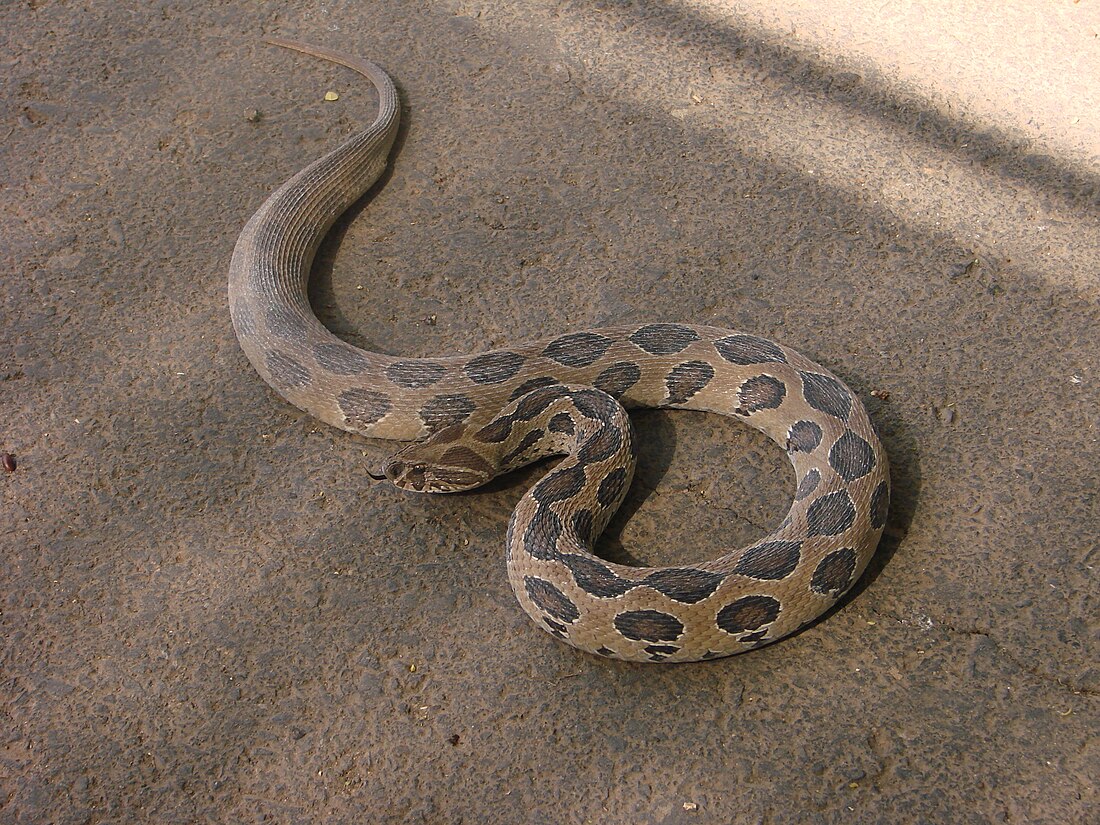Viperinae
Subfamily of snakes From Wikipedia, the free encyclopedia
Viperinae, or viperines, are a subfamily of vipers endemic to Europe, Asia and Africa. They are distinguished by their lack of the heat-sensing pit organs that characterize their sister group, the subfamily Crotalinae. Currently, 13 genera are recognized.[2] Most are tropical and subtropical, although one species, Vipera berus, even occurs within the Arctic Circle.[3] Like all vipers, they are venomous.
The common names "pitless vipers", "true vipers", "Old World vipers",[3] and "true adders"[4] all refer to this group.
Description
Members of this subfamily range in size from Bitis schneideri, which grows to a maximum total length (body and tail) of 280 mm (11 in), to the Gaboon viper, which reaches a maximum total length of over 2 m (6.6 ft). Most species are terrestrial, but a few, such as those of the genus Atheris, are completely arboreal.[3]
Although the heat-sensing pits that characterize the Crotalinae are clearly lacking in the viperines, a supernasal sac with sensory function has been described in a number of species. This sac is an invagination of the skin between the supranasal and nasal scales and is connected to the ophthalmic branch of the trigeminal nerve. The nerve endings here resemble those in the labial pits of boas. The supernasal sac is present in the genera Daboia, Pseudocerastes and Causus, but is especially well developed in the genus Bitis. Experiments have shown that strikes are not only guided by visual and chemical cues, but also by heat, with warmer targets being struck more frequently than colder ones.[3]
Geographic range
Viperinae are found in Europe, Asia, and Africa,[1] but not in Madagascar.[5]
Reproduction
Generally, members of this subfamily are ovoviviparous, although a few, such as Pseudocerastes, Cerastes, and some Echis species are oviparous (egg-laying).[3]
Genera
| Genus[2] | Taxon author[2] | Species[2] | Common name[3][6] | Geographic range[1] |
|---|---|---|---|---|
| Atheris | Cope, 1862 | 18 | Bush vipers | Tropical sub-Saharan Africa, excluding southern Africa. |
| Bitis | Gray, 1842 | 18 | Puff adders | Africa and the southern Arabian Peninsula. |
| Cerastes | Laurenti, 1768 | 3 | Horned vipers | North Africa eastward through Arabia and Iran. |
| Daboia | Gray, 1842 | 4 | Day adders | Pakistan, India, Sri Lanka, Bangladesh, Nepal, Myanmar, Thailand, Cambodia, China (Guangxi and Guangdong), Taiwan and Indonesia (Endeh, Flores, east Java, Komodo, Lomblen islands). |
| Echis | Merrem, 1820 | 12 | Saw-scaled vipers | India and Sri Lanka, parts of the Middle East and Africa north of the equator. |
| Eristicophis | Alcock and Finn, 1897 | 1 | McMahon's viper | The desert region of Balochistan near the Iran-Afghanistan-Pakistan border. |
| Macrovipera | Reuss, 1927 | 2 | Large Palearctic vipers | Semideserts and steppes of Northern Africa, the Near and Middle East, and Milos in the Aegean Sea. |
| Montatheris | Broadley, 1996 | 1 | Kenya mountain viper | Kenya: moorlands of the Aberdare Range and Mount Kenya above 3,000 m (9,800 ft). |
| Montivipera | Nilson, Tuniyev, Andren, Orlov, Joger, & Herrmann, 1999 | 8 | Upland vipers | Middle East |
| Proatheris | Broadley, 1996 | 1 | Lowland viper | Floodplains from southern Tanzania (northern end of Lake Malawi) through Malawi to near Beira, central Mozambique. |
| Pseudocerastes | Boulenger, 1896 | 3 | False-horned vipers | From the Sinai of Egypt eastward to Pakistan. |
| Vipera[a] | Laurenti, 1768 | 21 | Palearctic vipers | Great Britain and nearly all of continental Europe across the Arctic Circle and on some islands in the Mediterranean (Elba, Montecristo, Sicily) and Aegean Sea eastward across Northern Asia to Sakhalin and North Korea. Also found in Northern Africa in Morocco, Algeria and Tunisia. |
Taxonomy
Until relatively recently[when?], two other genera were also included in the Viperinae. However, they were eventually considered so distinctive within the Viperidae, that separate subfamilies were created for them:[1]
- Genus Azemiops — moved to subfamily Azemiopinae by Liem, Marx & Rabb (1971).
- Genus Causus — recognition of subfamily Causinae Cope, 1860 was proposed by Groombridge (1987) and further supported by Cadle (1992).
Nevertheless, these groups, together with the genera currently recognized as belonging to the Viperinae, are still often referred to collectively as the true vipers.[3]
Broadley (1996) recognized a new tribe, Atherini, for the genera Atheris, Adenorhinos, Montatheris and Proatheris, the type genus for which is Atheris.[1]
See also
References
Further reading
Wikiwand - on
Seamless Wikipedia browsing. On steroids.

